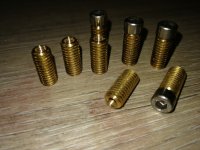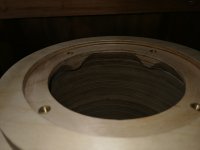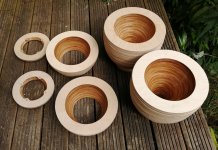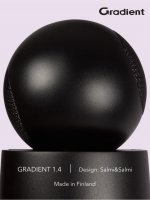A large influence in my design is Lawrence Dickie who designed the nautilus and now runs vivid. He uses the long spikes on the back of his drivers as closed transmission lines which extends the range over which the driver operates whilst controlling the rear energy. My design is similar. I am using a shorter absorption line that doesn't extend the range but does control the rear energy. Extending the range is not important to me as I will be using a subwoofer (or two)
Niffy
Niffy
By smoothing the surface it should act as an acoustic mirror.
Smoothing probably only affects the highest frequencies that are usually not an issue. At the frequencies of interest the small steps will not be seen, and create a more chaotic set of reflections.
a 12mm step would only be really effective above 10khz.
And smoothing will only affest even higher frequencies.
dave
Hi Dave,
"and create a more chaotic set of reflections."
My design goal is to produce a more controlled, less chaotic set of reflections that are channelled towards the rear of the cabinet. It is similar to making a horn loudspeaker, mine is a bit like a reverse horn. You don't see many stepped horns. Horns for high frequency are always smooth. By making the surface smooth the way the cabinet performs should be the same across as wide a frequency range as possible, maximising the advantages of using a full range driver.
The difference between leaving the surface stepped and smoothing it will probably not be large but every little helps.
Niffy
"and create a more chaotic set of reflections."
My design goal is to produce a more controlled, less chaotic set of reflections that are channelled towards the rear of the cabinet. It is similar to making a horn loudspeaker, mine is a bit like a reverse horn. You don't see many stepped horns. Horns for high frequency are always smooth. By making the surface smooth the way the cabinet performs should be the same across as wide a frequency range as possible, maximising the advantages of using a full range driver.
The difference between leaving the surface stepped and smoothing it will probably not be large but every little helps.
Niffy
I was looking at pictures of Gradient 1.4 speaker and thought that one could make quite similar speaker using a full range driver. Stacking plywood would be an obvious option to create a spherical enclosure.
Hi Nikolas,
Apart from using IKEA salad bowls translam has got to be the easiest way for the DIYist to make a spherical loudspeaker. I've had a quick look at the Gradient speakers. This might be a difficult speaker to copy as the designer is giving very little away as to the internal structure. One of the benefits of translam is the ability to make more complex shapes, both external and internal, than is possible with more conventional construction. I prefer the option of full range to coaxial, no crossover.
Spherical cabinets with differently shaped insides can be made by several different methods though none are as DIY friendly as translam.
They can be machined from a solid billet. This would require a much more comprehensive workshop than I have available. I believe that this is how B&W produce the turbine head for their 800 series speakers.
The shapes could be layed up using composite materials such as glass fibre. This would need a mold/former to create the desired shape. This could be also made from glass fibre layed up on a lightweight former made of expanding foam or similar. You could make the inner and outer shapes separately and fill the space between them with a lightweight foam or some form of damping materials. This is how Vivid produce the cabinets for bass sections of their speakers. It might not be the best choice for mid and high frequencies.
The cabinets could also be cast from a loaded resin or even concrete. This would again need molds to be produced. How you would remove the internal pieces of the mold could be a challenge.
Getting really up to date there is 3D printing as shown by the link to the Jordan website.
Translam has advantages over all of these options in many ways.
Translam can be done with only a relatively modest toolkit.
Translam is cheap. Even though I am using high quality baltic birch plywood the total cost of building my cabinets, including all the tools, fixings and finishing materials, is less than £200.
If done well translam produces a really good finish. All of the other construction methods would require painting or similar, except maybe casting if a decorative resin is used. The wood finish of translam looks better than this (my personal taste of course)
Niffy
Apart from using IKEA salad bowls translam has got to be the easiest way for the DIYist to make a spherical loudspeaker. I've had a quick look at the Gradient speakers. This might be a difficult speaker to copy as the designer is giving very little away as to the internal structure. One of the benefits of translam is the ability to make more complex shapes, both external and internal, than is possible with more conventional construction. I prefer the option of full range to coaxial, no crossover.
Spherical cabinets with differently shaped insides can be made by several different methods though none are as DIY friendly as translam.
They can be machined from a solid billet. This would require a much more comprehensive workshop than I have available. I believe that this is how B&W produce the turbine head for their 800 series speakers.
The shapes could be layed up using composite materials such as glass fibre. This would need a mold/former to create the desired shape. This could be also made from glass fibre layed up on a lightweight former made of expanding foam or similar. You could make the inner and outer shapes separately and fill the space between them with a lightweight foam or some form of damping materials. This is how Vivid produce the cabinets for bass sections of their speakers. It might not be the best choice for mid and high frequencies.
The cabinets could also be cast from a loaded resin or even concrete. This would again need molds to be produced. How you would remove the internal pieces of the mold could be a challenge.
Getting really up to date there is 3D printing as shown by the link to the Jordan website.
Translam has advantages over all of these options in many ways.
Translam can be done with only a relatively modest toolkit.
Translam is cheap. Even though I am using high quality baltic birch plywood the total cost of building my cabinets, including all the tools, fixings and finishing materials, is less than £200.
If done well translam produces a really good finish. All of the other construction methods would require painting or similar, except maybe casting if a decorative resin is used. The wood finish of translam looks better than this (my personal taste of course)
Niffy
You don't see many stepped horns.
There are lots of them. A whole family. Olson/Nagaoka style horns. Only useful for bass, but the discontinuities help depress the HF.
Horns for high frequency are always smooth
To preserve the HF. If your TL is not half-wave long and full of damping it is all going to reflect back like a laser beam.
dave
Are you trying to instill fear, uncertainty and doubt? The magnet will reflect the laser beam of sound if the damping doesn't absorb it.
I've had a quick look at the Gradient speakers. This might be a difficult speaker to copy as the designer is giving very little away as to the internal structure.
It could be easy because the structure looks simple. There is a driver, some fill inside the enclosure, and some kind of acoustic resistance.
Attachments
Hi Nikolas,
I was thinking more of the internal shape of the speaker. Is it spherical internally? The write up hints at a port as well as some form of defuser, which I guess is the perforated disc. How and where these are implemented is not clear. The write up mentions controlling dispersion from the rear of the cabinet. How this is achieved is not described.
I would suggest starting with a good full range driver, like the Jordan or Mark Audio. Calculate the ideal internal volume for your chosen driver and design your own spherical cabinet based on this. I would avoid making the inside a perfect sphere. With translam you can make the shapes anything you like. I would recommend making the walls quite thick as translam is not as rigid as using plywood as sheets.
Niffy
I was thinking more of the internal shape of the speaker. Is it spherical internally? The write up hints at a port as well as some form of defuser, which I guess is the perforated disc. How and where these are implemented is not clear. The write up mentions controlling dispersion from the rear of the cabinet. How this is achieved is not described.
I would suggest starting with a good full range driver, like the Jordan or Mark Audio. Calculate the ideal internal volume for your chosen driver and design your own spherical cabinet based on this. I would avoid making the inside a perfect sphere. With translam you can make the shapes anything you like. I would recommend making the walls quite thick as translam is not as rigid as using plywood as sheets.
Niffy
The difference in going to be very dependent on the shape of the cabinet. If we take Ian's transmission lines as an example and look at a side panel. The thickness of material looks to be similar to the thickness of a standard sheet. The rigidity front to back will be similar to that of as half the grain runs front to back in both cases. Vertically the translam will be a lot less rigid. However the majority of the overall rigidity with the sheet is front to back as this is a much smaller dimension. The same is true for the translam. The difference is much smaller with a long narrow panel than a square one. Also the internal panel will further mitigate any difference. One area where translam has a distinct advantage is in the joints between panels. The corners of a cabinet like Ian's will be much more rigid than a butt joint. Overall Ian's cabinet is probably not much less rigid than if it were made of panels in a more conventional way.
The rigidity of the panel can be increased by making it thicker. This will also increase the mass. This will result in the resonant frequency of the panel being lowered. For this reason I would not use translam for a subwoofer. With a subwoofer you want the rigidity to mass ratio to be high so that the resonant frequency of the panels is way above the frequencies at which the subwoofer will be used. You also want the Q of the cabinet to be high so that it can only excited by a single frequency. As this frequency will be well outside of the passband, no problem.
For a fullrange or midrange the resonant frequency of the cabinet will inevitably fall within the passband. In this case you still want high rigidity but you want the cabinet to have a low Q so that it is only excited a little bit over a wide range of frequencies. For this reason translam is a good choice for speakers that are operating from the mid-bass and above.
Of course the properties of cabinet can be enhanced by making it in a more rigid shape like a sphere.
Niffy
The rigidity of the panel can be increased by making it thicker. This will also increase the mass. This will result in the resonant frequency of the panel being lowered. For this reason I would not use translam for a subwoofer. With a subwoofer you want the rigidity to mass ratio to be high so that the resonant frequency of the panels is way above the frequencies at which the subwoofer will be used. You also want the Q of the cabinet to be high so that it can only excited by a single frequency. As this frequency will be well outside of the passband, no problem.
For a fullrange or midrange the resonant frequency of the cabinet will inevitably fall within the passband. In this case you still want high rigidity but you want the cabinet to have a low Q so that it is only excited a little bit over a wide range of frequencies. For this reason translam is a good choice for speakers that are operating from the mid-bass and above.
Of course the properties of cabinet can be enhanced by making it in a more rigid shape like a sphere.
Niffy
Driver mounting hardware
I forgot to mention a very important stage when I said what my next steps would be. This was to chamfer the inside of the baffles leaving stanchions for the mounting hardware and to make the hardware itself. The chamfer was cut using a 45° profile router bit. The front of the internal ellipsoid meets the driver at 45° so the chamfer will blend into it smoothly. I couldn't find any threaded inserts that I liked so I made my own. They are made from M8 threaded bar that I have drilled and internally tapped to M5. The stanchions in the baffle are drilled and tapped. The inserts were covered in araldite and screwed in using the M5 bolts. Once the glue had set the bolts were removed.


Niffy
I forgot to mention a very important stage when I said what my next steps would be. This was to chamfer the inside of the baffles leaving stanchions for the mounting hardware and to make the hardware itself. The chamfer was cut using a 45° profile router bit. The front of the internal ellipsoid meets the driver at 45° so the chamfer will blend into it smoothly. I couldn't find any threaded inserts that I liked so I made my own. They are made from M8 threaded bar that I have drilled and internally tapped to M5. The stanchions in the baffle are drilled and tapped. The inserts were covered in araldite and screwed in using the M5 bolts. Once the glue had set the bolts were removed.


Niffy
Aperiodic possibilities
Maybe.
But I don't know really. It could be a straight cylinder as well. An enclosure that is spherical from the outside should be good at avoiding diffractions. I think that Gradient was more interested about internal volume and distance between the driver and vent, and less interested in internal shape. The speaker seems to be well stuffed with some wool (polyester or something). It is a resistance enclosure.
What I have understood is that the acoustic resistance leaks and partially cancels sounds radiating wrong direction.
I see that translam allows very complex acoustical labyrinths. It is one possible way to make a speaker aperiodic. An aperiodic vent is another.
I was thinking more of the internal shape of the speaker. Is it spherical internally?
Maybe.
But I don't know really. It could be a straight cylinder as well. An enclosure that is spherical from the outside should be good at avoiding diffractions. I think that Gradient was more interested about internal volume and distance between the driver and vent, and less interested in internal shape. The speaker seems to be well stuffed with some wool (polyester or something). It is a resistance enclosure.
The write up mentions controlling dispersion from the rear of the cabinet. How this is achieved is not described.
What I have understood is that the acoustic resistance leaks and partially cancels sounds radiating wrong direction.
I would avoid making the inside a perfect sphere. With translam you can make the shapes anything you like. I would recommend making the walls quite thick as translam is not as rigid as using plywood as sheets.
Niffy
I see that translam allows very complex acoustical labyrinths. It is one possible way to make a speaker aperiodic. An aperiodic vent is another.
Internal finishing
I've glued the rear and middle sections together, sanded the joins smooth and varnished all the inside bits. I used a rustins satin finish clear varnish. It came out a darker colour than I had imagined. It is also a much nicer colour than I expected and much more fitting to my decor. Very fortuitous. I'll definitely be finishing the exterior to this colour.

Niffy
I've glued the rear and middle sections together, sanded the joins smooth and varnished all the inside bits. I used a rustins satin finish clear varnish. It came out a darker colour than I had imagined. It is also a much nicer colour than I expected and much more fitting to my decor. Very fortuitous. I'll definitely be finishing the exterior to this colour.

Niffy
Nice inserts. I used Araldite to glue E-nuts into the edge of ply to make rear panel of my VTL's removable, worked well
Hi Nikolas,
I found this side view of the gradient speaker.

Now it makes sense. The spherical cabinet has equal sized grills front and back with an aperiodic vent the size of the driver behind the rear one. I'm guessing that the interior of the cabinet is probably spherical.
A cabinet of this shape should be easy to construct using translam. Hopefully you can find suitable grills.
I've not seen the Jordan Eikona used in an aperiodic cabinet before but can see no reason why it wouldn't work. You would have the benefit over the gradient of loosing the crossover.
Niffy
I found this side view of the gradient speaker.

Now it makes sense. The spherical cabinet has equal sized grills front and back with an aperiodic vent the size of the driver behind the rear one. I'm guessing that the interior of the cabinet is probably spherical.
A cabinet of this shape should be easy to construct using translam. Hopefully you can find suitable grills.
I've not seen the Jordan Eikona used in an aperiodic cabinet before but can see no reason why it wouldn't work. You would have the benefit over the gradient of loosing the crossover.
Niffy
I've glued all of the sections together with the exception of the back panel. I'll give the glue a bit of time to cure then it will be sanding the joins smooth and a quick lick of varnish. The sections fit together very well so the sanding should be nice and easy. Smoothing the sections together like this will probably have no real effect on sound quality but I want to do it for completeness sake.
I haven't glued the back panel on yet so that I can screw into the rear section to attach it to the turntable. After the front is shaped I'll glue on the rear and attach the speaker to the turntable using the driver mounting inserts.
Niffy
I haven't glued the back panel on yet so that I can screw into the rear section to attach it to the turntable. After the front is shaped I'll glue on the rear and attach the speaker to the turntable using the driver mounting inserts.
Niffy
Ted Jordan's VTL Loudspeaker
I think it should be a safe guess after reading this: A history of Ted Jordan's VTL Loudspeaker - E J Jordan Designs
I've not seen the Jordan Eikona used in an aperiodic cabinet before but can see no reason why it wouldn't work.
I think it should be a safe guess after reading this: A history of Ted Jordan's VTL Loudspeaker - E J Jordan Designs
External shaping begins
I've started the external shaping of the first cabinet. So far I have shaped what will be the front 2/3rds of the cabinet. I started with an angle grinder sanding wheel. I've finished off with a palm sander and hand sanding. To the naked eye the shape looks perfect. Only when running my hand over the surface can I feel the slightest undulations. I'm afraid that if I try and smooth this out further I might muck up the shape. The undulations are so slight I'll probably leave it as is.
View attachment 873167
View attachment 873168
View attachment 873169
Niffy
I've started the external shaping of the first cabinet. So far I have shaped what will be the front 2/3rds of the cabinet. I started with an angle grinder sanding wheel. I've finished off with a palm sander and hand sanding. To the naked eye the shape looks perfect. Only when running my hand over the surface can I feel the slightest undulations. I'm afraid that if I try and smooth this out further I might muck up the shape. The undulations are so slight I'll probably leave it as is.
View attachment 873167
View attachment 873168
View attachment 873169
Niffy
- Home
- Loudspeakers
- Full Range
- Jordan Eikona Translam Ellipsoid
